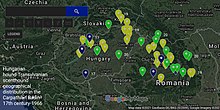Transylvanian Hound
[1] The tall variety was used for hunting woodland and grassland big game, such as European bison, Eurasian brown bear, boar, and lynx.
[1] The breed declined and was marginalised to the Carpathian woodlands, shrinking with the growth of agriculture and forestry, and by the beginning of the twentieth century it was nearly extinct.
[3][5] In 1886 the first official registration of the breed began with the "Hungarian Hunting Dog Pedigree" (Magyar Vadászeb Törzskönyv).
[7] The breed was recognised and standardised by the Fédération Cynologique Internationale in 1963, with definitive acceptance on 30 March in that year.
[3][10] It has a typical scent hound head, long but not pointed and free from wrinkles; the ears are medium-sized and pendent, wide in the middle and tapering to a rounded tip.
[4][10] The continental climate of its native land, with its hot summers and cold winters with heavy snow falls, has resulted in a breed with great stamina as well as a very keen and reliable scenting ability.
[4][10][2][12] It is described as being reserved, slightly suspicious and introspective in character; when hunting it shows courage and a good sense of orientation.



